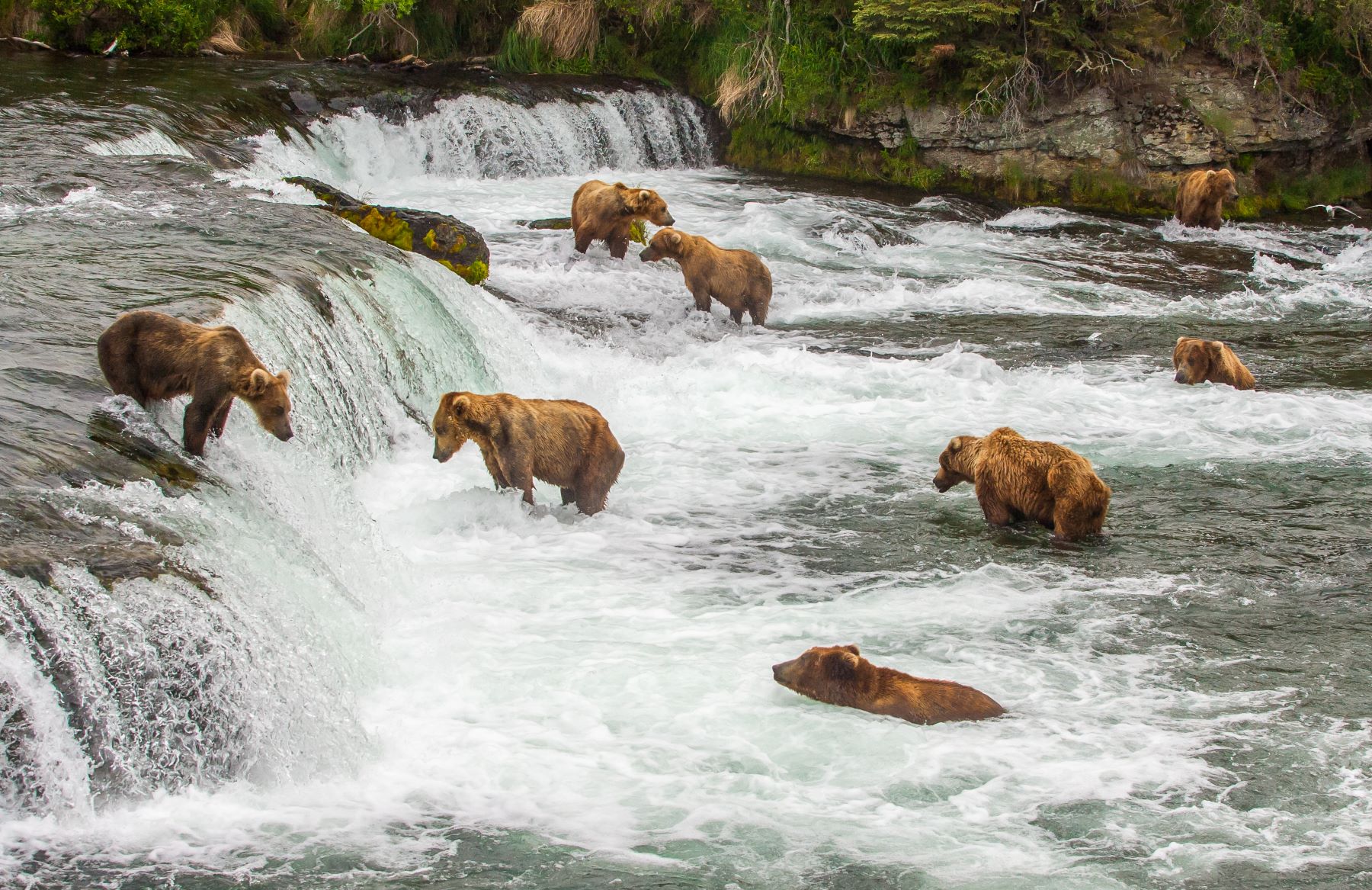Home to eight national parks covering 56 million acres, Alaska offers travelers unparalleled opportunities for wildlife viewing in our incredible and varied public lands. From towering peaks to stunning fjords, Alaska's national parks showcase some of the most breathtaking and diverse landscapes found across the world. Travelers looking to enjoy scenic beauty while encountering animals in their natural habitats will find endless wildlife viewing opportunities, from watching grizzly bears and moose to humpback whales and soaring bald eagles.
Denali National Park and Preserve

Denali, named after North America’s highest peak, offers an iconic wildlife viewing experience in Alaska’s Interior region. Although most visitors come to see the "Big Five": bears, moose, caribou, wolves, and Dall sheep, the park is home to a total of 39 species of mammals and 130 different bird species.
Wildlife Highlights:
- Grizzly bears and black bears
- Moose
- Caribou
- Gray wolves
- Birds
Best Viewing Tips: The Denali Park Road is a prime area for spotting wildlife, particularly during early mornings or late evenings. Bus tours provide guided opportunities to see animals while minimizing human impact.
Get Here By: Road, Train, Plane
Kenai Fjords National Park

Located near Seward on the Kenai Peninsula, Kenai Fjords National Park is a breathtaking combination of glaciers, fjords, and marine ecosystems. The park’s proximity to the Gulf of Alaska makes it a hotspot for marine wildlife.
Wildlife Highlights:
- Marine animals including humpback whales, orcas, sea otters, and harbor seals
- Black bears and mountain goats along the coastline
- Puffins and other seabirds
- Bald eagles
Best Viewing Tips: Day cruises departing from Seward offer an excellent way to observe marine wildlife. Kayaking tours from Seward also provide close encounters with sea otters and birds.
Get Here By: Road, Train, Plane, Boat
Glacier Bay National Park and Preserve

Glacier Bay, part of a UNESCO World Heritage Site, is a spectacular combination of tidewater glaciers, fjords, and lush forests. It’s a 3.3-million-acre sanctuary for both marine and land wildlife in the Inside Passage.
Wildlife Highlights:
- Marine animals including Steller sea lions, humpback whales, and harbor porpoises
- Land animals including black bears and mountain goats
- Birdlife including puffins, murrelets, shearwaters, oystercatchers, hummingbirds, and petrels
Best Viewing Tips: Cruise ships and day cruises offer unparalleled views of marine life and bird colonies. Kayaking near the glaciers provides a serene, immersive wildlife experience.
Get Here By: Boat
Wrangell-St. Elias National Park and Preserve

As the largest national park in the country, Wrangell-St. Elias encompasses an expansive wilderness of glaciers, mountains, and rivers. Its remote landscape is home to a wide variety of wildlife.
Wildlife Highlights:
- Dall sheep
- Moose and caribou
- Grizzly and black bears
- Golden eagles
Best Viewing Tips: Guided day hikes, rafting trips, and overnight backcountry treks from McCarthy and Kennicott offer the best opportunities to spot wildlife in this vast and remote park.
Get Here By: Road, Plane
Katmai National Park and Preserve

In Alaska’s Southwest region, Katmai National Park is well known as one of the most iconic places to view brown bears in the world, along with its unique volcanic landscape in the Valley of 10,000 Smokes. The park’s rivers and lakes are full of salmon, attracting one of the largest populations of brown bears in the world.
Wildlife Highlights:
- Brown bears
- Salmon
- Other land animals including wolves, foxes, and moose
Best Viewing Tips: Brooks Camp offers raised platforms for safe bear viewing, especially in July and September during peak salmon runs. Guided tours enhance the experience with expert insights.
Get Here By: Plane, Boat
Lake Clark National Park and Preserve

Lake Clark’s landscape is dominated by two active volcanoes and more than 900 square miles of glaciers. A variety of wildlife live among its coastline, forests, and lakes. Its remote location in the Southwest region makes it the perfect spot for wildlife enthusiasts who like to travel off-the-beaten path.
Wildlife Highlights:
- Brown bears
- Moose
- Swans
- Bald eagles
Best Viewing Tips: The park is best accessed via small planes. Book a bear viewing day trip or stay in a wilderness lodge with guided excursions. Crescent Lake and Silver Salmon Creek are prime locations for bear viewing.
Gates of the Arctic National Park and Preserve

Gates of the Arctic, situated above the Arctic Circle, is the epitome of remote wilderness. The park is a vast, roadless landscape the size of Switzerland, with no National Park Service facilities, visitor centers, or campgrounds. It is home to one village, Anaktuvuk Pass, while eight small Alaska Native villages, each with fewer than 400 residents, surround its perimeter.
Wildlife Highlights:
- Caribou
- Grizzly bears
- Wolves
Best Viewing Tips: Backcountry backpacking and rafting trips along the rivers provide opportunities to encounter wildlife in this remote setting. Visitors should book guided experiences with travel operators, as the park has no developed facilities.
Get Here By: Plane
Kobuk Valley National Park

In the Arctic region, Kobuk Valley is a remote and lesser-known park offering a mix of unique landscapes and wildlife. Visitors most often travel there to see the caribou migration at Onion Portage.
Wildlife Highlights:
- Caribou
- Bears
- Wolves
- Birds
Best Viewing Tips: Flightseeing tours provide sweeping views of the caribou migration, while guided rafting trips along the Kobuk River offer a closer look at the area's wildlife.
Get Here By: Plane
Alaska: AKA Your Next Adventure
Where will your Alaska adventure take you? Order our Official State of Alaska Vacation Planner and plot your course.

